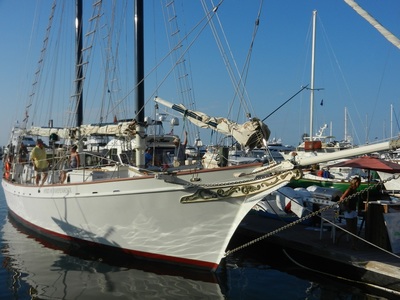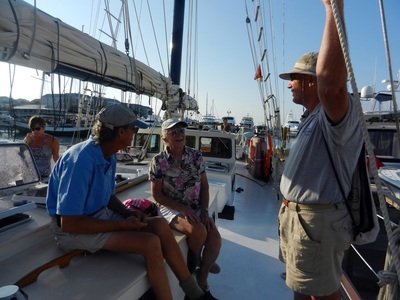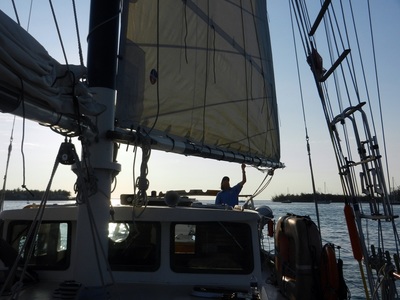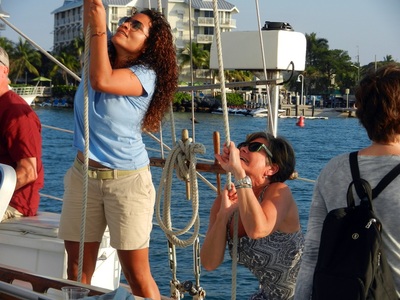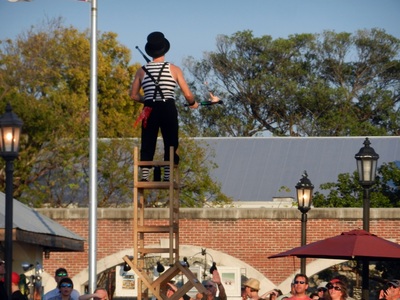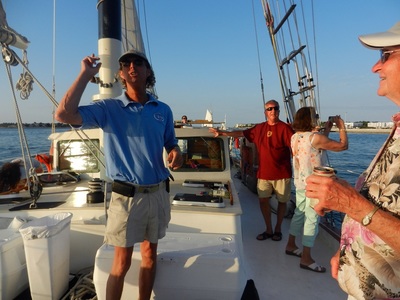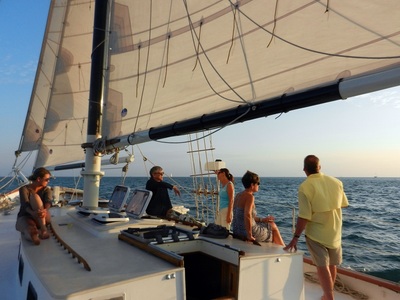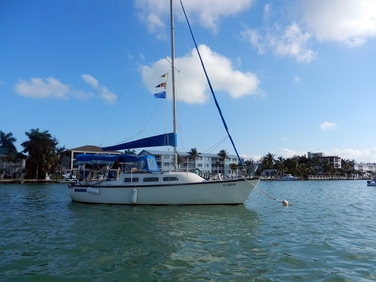 Orion Jr on her mooring in Marathon
Orion Jr on her mooring in Marathon The Seafood Festival marks a tipping point of sorts for the winter season in Marathon. Soon after it ends, the waiting list for moorings shortens and then disappears. During the morning net, we are "saying goodbye" to more departing vessels, than "hello" to new boats in the harbor. And, for us, it means that we realize the number of days before we haul Orion Jr out of the water for the trip north is quickly decreasing. As a result, we become more – hmm – focused on any boat projects that have been deferred until now.
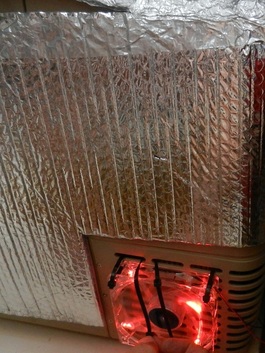
Cooling Down As Temperatures Rise
The temperatures were rising and staying up. Of course that was true of the outside air temperature, but we were much more focused on the ice box and freezer temperatures than the increasing heat. Not that they were unrelated. Once we realized we had a problem, it was becoming increasingly difficult to get the cold storage temperatures back down to where they should be. Our bottles of ice were coming out of the freezer less than solidly frozen. Which meant the ice in the bottles wasn't lasting two days as was necessary to ensure a cold enough ice box. We actually wanted to freeze more bottles of water, but with the freezer struggling with its current load, this wasn't going to work.
We started tackling the problem on a number of fronts. First, we looked at the overall temperature in the boat. As the days and nights were warming up, the boat's interior temperature would soar and not cool down until late in the evening. So, we started leaving the forward hatch open during the day. (Of course, the 2nd day we tried this, we had an unexpected downpour while we were away from the boat.) We also discovered that the solar vent battery was not charging any more and the vent had not been running as it should. So, we replaced it and got it charged up. This would give us ventilation when the hatch had to be closed. We tried adding a tarp over the forward deck, covering the hatch (which was a trade-off, since the solar vent couldn't charge). This helped some, but it was still pretty warm below, rising to the mid to upper 80's during the day.
We also tried working on reducing the work the freezer would have to do. We used our connections with Paul at the Seafood Festival to freeze a few bottles of water overnight each night of the festival in their refrigerated trucks, where they kept the frozen goods. This worked great. We had solid bottles of water for the ice box in the morning and even had some to spare to put into the freezer. By the end of the weekend, the ice box temperatures were staying in the low 40's, where we like to see them. We also had 4 bottles of ice to cycle in each day (2 large and 2 small), which was making the cycle repeatable.
However, the freezer was still struggling with temperatures in the mid- to upper 20's. Too warm. Dave had another idea from the reading he had done on the internet. He added a fan outside the freezer, blowing air into the vents on one side. These had been feeling very warm, making Dave think the internal fan was struggling to dissipate the heat. This turned out to be silver bullet. The freezer was able to chill down to the teens and even single digits on occasion! Since then, we've managed to keep the equilibrium in both the ice box and freezer, so the system is working again.
I think I'll have a cold drink to celebrate.
The temperatures were rising and staying up. Of course that was true of the outside air temperature, but we were much more focused on the ice box and freezer temperatures than the increasing heat. Not that they were unrelated. Once we realized we had a problem, it was becoming increasingly difficult to get the cold storage temperatures back down to where they should be. Our bottles of ice were coming out of the freezer less than solidly frozen. Which meant the ice in the bottles wasn't lasting two days as was necessary to ensure a cold enough ice box. We actually wanted to freeze more bottles of water, but with the freezer struggling with its current load, this wasn't going to work.
We started tackling the problem on a number of fronts. First, we looked at the overall temperature in the boat. As the days and nights were warming up, the boat's interior temperature would soar and not cool down until late in the evening. So, we started leaving the forward hatch open during the day. (Of course, the 2nd day we tried this, we had an unexpected downpour while we were away from the boat.) We also discovered that the solar vent battery was not charging any more and the vent had not been running as it should. So, we replaced it and got it charged up. This would give us ventilation when the hatch had to be closed. We tried adding a tarp over the forward deck, covering the hatch (which was a trade-off, since the solar vent couldn't charge). This helped some, but it was still pretty warm below, rising to the mid to upper 80's during the day.
We also tried working on reducing the work the freezer would have to do. We used our connections with Paul at the Seafood Festival to freeze a few bottles of water overnight each night of the festival in their refrigerated trucks, where they kept the frozen goods. This worked great. We had solid bottles of water for the ice box in the morning and even had some to spare to put into the freezer. By the end of the weekend, the ice box temperatures were staying in the low 40's, where we like to see them. We also had 4 bottles of ice to cycle in each day (2 large and 2 small), which was making the cycle repeatable.
However, the freezer was still struggling with temperatures in the mid- to upper 20's. Too warm. Dave had another idea from the reading he had done on the internet. He added a fan outside the freezer, blowing air into the vents on one side. These had been feeling very warm, making Dave think the internal fan was struggling to dissipate the heat. This turned out to be silver bullet. The freezer was able to chill down to the teens and even single digits on occasion! Since then, we've managed to keep the equilibrium in both the ice box and freezer, so the system is working again.
I think I'll have a cold drink to celebrate.
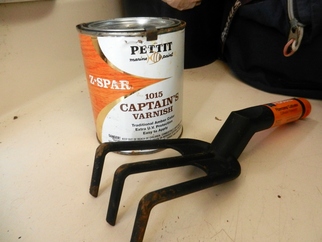
Varnishing the Hard Way
"Honey, have you seen the varnish?", Cathy asked innocently, despite her growing unease that it wasn't anywhere to be found. Not surprisingly, Dave hadn't seen it all season. But Cathy had. Soon after arriving in Marathon, she had moved it from its normal, difficult-to-reach location far forward to some compartment further aft. But when she looked where it should be – nothing. After turning out every compartment on board, and even scouring the truck, she was beside herself with frustration. The wood had all been prepped. The weather was perfect for varnishing. Where was it?
And then, it clicked. She removed all the contents of the starboard compartment in the V-berth, took a flashlight and a mirror and stuck it down inside. Way down in an inaccessible part of the bilge sat the nearly full quart can of varnish. Now, what? With no obvious solution for retrieving it, she hedged her bets and ordered another can. It would take a week to arrive. In the meantime, she needed to think of a way to retrieve it. Having a rusty can of varnish leaking its contents into the bilge on some future date was a pretty ugly scenario.
The first idea was a BIG magnet. She quickly got a response when she put out the call on the net from a nearby boat. Of course this required wedging her upper body into an opening that was just big enough in order to maneuver the magnet, a PVC pole, a flashlight and a mirror into the hole. After 4 hours of repeated attempts, she had managed to turn the can from its upright position onto its side, and lose 2 mirrors and a flashlight. On the positive side, she managed to retrieve 2 long-missing screwdrivers and the flashlight. The trend was not good, though. Time to go back to the drawing board.
Giving the bruises time to heal, it took a couple of days and a scouring of shelves at Home Depot to devise the next approach. It involved a garden fork. Initially, this managed to pull the 2 mirrors out, but was it possible that the varnish was getting further away? Yep. Maybe it was time to cut a hole in the Main Saloon floor? Dave wasn't buying this.
So, back to the compartment from hell. She needed something that could solidly hold the garden fork, start out short and telescope to the far end of the bilge where the varnish now sat. Dave came up with the tiller extension. Although Cathy was losing hope, it seemed to be the best idea. After a few more misses, she was able to move the can just a little. Then a little more. It would slip back some, but not all the way. Slowly. Slowly. Closer. Closer. Closer. GOT IT! Hooray!!!
"Honey, have you seen the varnish?", Cathy asked innocently, despite her growing unease that it wasn't anywhere to be found. Not surprisingly, Dave hadn't seen it all season. But Cathy had. Soon after arriving in Marathon, she had moved it from its normal, difficult-to-reach location far forward to some compartment further aft. But when she looked where it should be – nothing. After turning out every compartment on board, and even scouring the truck, she was beside herself with frustration. The wood had all been prepped. The weather was perfect for varnishing. Where was it?
And then, it clicked. She removed all the contents of the starboard compartment in the V-berth, took a flashlight and a mirror and stuck it down inside. Way down in an inaccessible part of the bilge sat the nearly full quart can of varnish. Now, what? With no obvious solution for retrieving it, she hedged her bets and ordered another can. It would take a week to arrive. In the meantime, she needed to think of a way to retrieve it. Having a rusty can of varnish leaking its contents into the bilge on some future date was a pretty ugly scenario.
The first idea was a BIG magnet. She quickly got a response when she put out the call on the net from a nearby boat. Of course this required wedging her upper body into an opening that was just big enough in order to maneuver the magnet, a PVC pole, a flashlight and a mirror into the hole. After 4 hours of repeated attempts, she had managed to turn the can from its upright position onto its side, and lose 2 mirrors and a flashlight. On the positive side, she managed to retrieve 2 long-missing screwdrivers and the flashlight. The trend was not good, though. Time to go back to the drawing board.
Giving the bruises time to heal, it took a couple of days and a scouring of shelves at Home Depot to devise the next approach. It involved a garden fork. Initially, this managed to pull the 2 mirrors out, but was it possible that the varnish was getting further away? Yep. Maybe it was time to cut a hole in the Main Saloon floor? Dave wasn't buying this.
So, back to the compartment from hell. She needed something that could solidly hold the garden fork, start out short and telescope to the far end of the bilge where the varnish now sat. Dave came up with the tiller extension. Although Cathy was losing hope, it seemed to be the best idea. After a few more misses, she was able to move the can just a little. Then a little more. It would slip back some, but not all the way. Slowly. Slowly. Closer. Closer. Closer. GOT IT! Hooray!!!
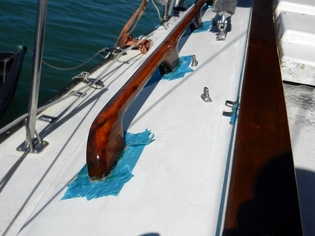
So, a week after she thought she was going to get started, the first coat of varnish finally went on.
And then, of course, another can arrived in the mail.
Well, we surely won't run out of varnish this year.
And then, of course, another can arrived in the mail.
Well, we surely won't run out of varnish this year.
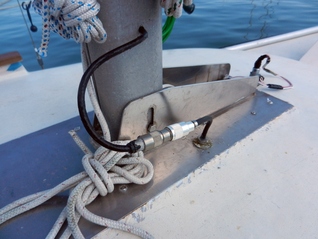 New VHF wire connection on deck
New VHF wire connection on deck Making Better Connections
Shortly after arriving in Marathon, we started listening to the morning VHF radio net. (Basically, this is a daily get-together for the boats in the harbor to know what's going on and to help each other out.) However, we quickly discovered we were missing large sections because we couldn't hear boats that were more than a short distance away. Since it's not that big of a harbor, we started to suspect it was our VHF radio that was the problem, not the boats that were transmitting. Although we installed a new VHF back in 2011, along with a new wire up the mast to the antenna, there was a weak link in the set-up. The wire that ran from the base of the mast inside the cabin to the radio was original and, as such, suspect. We didn't know how old it was, and there was an unnecessary splice in the middle, which would degrade the signal by its presence even in the best of conditions. So, we were pretty sure that replacing this length would improve our reception and likely our transmission as well.
Once Dave had assembled all of the wire and connectors needed to install it, we were ready to begin. His attention was first put on the most vulnerable section, which was the 2 ft length that sits on deck between the base of the mast and the deck fitting. He was able to protect the new wire with some heat shrink, which he could add before the connectors went on. However, the existing wire from the mast needed some protection as well, and heat shrink wouldn't work because of the connector already in place. So, he used a liquid electrical tape to coat it. This would give some better protection from both UV and water damage.
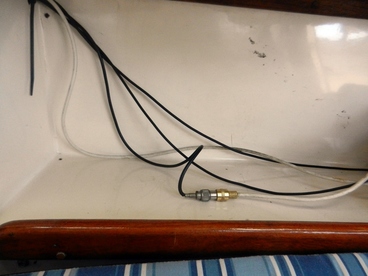 Messy VHF wires that are now neatly stowed.
Messy VHF wires that are now neatly stowed. Now we were ready to run the wire through the deck into the boat's interior. It was pretty easy to route it along the same path as the wire it was replacing all the way into the Main Saloon. At that point, we were able to remove the klunky splice and have a seamless run along the top of the wall back to the radio. With the longer wire, it could also be routed into the radio from behind and more out the way. Dave could then solder on the final fitting to connect to the radio. And a quick test revealed we were back on the air. During the next morning's net we could hear clearly and seemed to be heard as well. Some of the transmissions that had been full of static were clear now and we were less impacted by the electronic devices charging on the boat. Pretty good reinforcement that this was the answer to the problem.
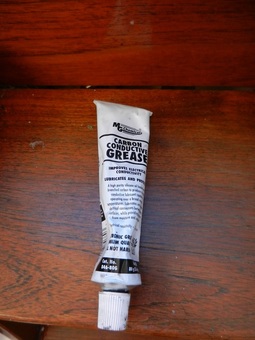 Carbon Conductive Grease
Carbon Conductive Grease We still wondered about what would happen when we took the mast down and the connection sat exposed for several months. Not only were the VHF connections exposed. We also had connections for the anchor light and the stereo speakers. To make the process of stowing and commissioning the boat easier, Dave had just installed a two-pin connector on the engine wires as well. These are all vulnerable to corrosion. From Dick on Tarwathie, Dave learned of a possible solution, called Carbon Conductive grease. It protects the metal connections from corrosion and promotes conductivity across them. So, Dave not only put this on the VHF radio connections on deck, he also coated all of the pins for the connections that would be exposed once we trailer the boat: the engine wire, anchor light, stereo speakers, etc. The hope is that when we re-commission the boat after several months of idleness, we won't have as many connections that need to be cleaned of corrosion. Only time will tell.
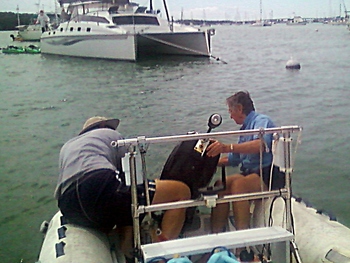 Dave helps Tarun clean the outboard intakes
Dave helps Tarun clean the outboard intakes Cleaning Up
Boats, both inside and out, are breeding grounds for unwanted growth. With the solar fan out of commission, the 4 weeks in storage over Christmas had not been kind to Orion Jr's interior. Mildew was everywhere. As a result, Cathy was having trouble with allergies for the first time in years. Red, itchy eyes. So, we started cleaning out all the compartments, washing cushion covers, spraying with Lysol, and airing things out. Unfortunately, our weight reduction exercise in the fall had removed the ozone generator. A quick call out on the net yielded one for a loaner and the problems seemed to resolve themselves.
But that's just the inside. Up on deck, the accumulated grime from months of just sitting had never completely been cleaned off. Cathy took advantage of a rain storm rinse to wax the freshly washed deck and take off some of the tougher dirt. It never really shines, but it does protect what's there. With the warmer temperatures, the organisms start finding the places to grow below the waterline as well. We started to be more rigorous in cleaning the dinghy bottom each week. And Dave started scraping the bottom of the big boat weekly as well, reaching as far as he could from the dinghy. So far, the barnacles are few and small, but that is gradually changing. And it's not just our boat. Dave found himself working on a friend's outboard that was showing signs that the water flow was less than it should be because the intakes were fouled. With some elbow grease, the flow seemed to be restored.
So, for a minute, everything looks spic n span. And then it starts all over. It's all in a day's work on a boat.
Boats, both inside and out, are breeding grounds for unwanted growth. With the solar fan out of commission, the 4 weeks in storage over Christmas had not been kind to Orion Jr's interior. Mildew was everywhere. As a result, Cathy was having trouble with allergies for the first time in years. Red, itchy eyes. So, we started cleaning out all the compartments, washing cushion covers, spraying with Lysol, and airing things out. Unfortunately, our weight reduction exercise in the fall had removed the ozone generator. A quick call out on the net yielded one for a loaner and the problems seemed to resolve themselves.
But that's just the inside. Up on deck, the accumulated grime from months of just sitting had never completely been cleaned off. Cathy took advantage of a rain storm rinse to wax the freshly washed deck and take off some of the tougher dirt. It never really shines, but it does protect what's there. With the warmer temperatures, the organisms start finding the places to grow below the waterline as well. We started to be more rigorous in cleaning the dinghy bottom each week. And Dave started scraping the bottom of the big boat weekly as well, reaching as far as he could from the dinghy. So far, the barnacles are few and small, but that is gradually changing. And it's not just our boat. Dave found himself working on a friend's outboard that was showing signs that the water flow was less than it should be because the intakes were fouled. With some elbow grease, the flow seemed to be restored.
So, for a minute, everything looks spic n span. And then it starts all over. It's all in a day's work on a boat.
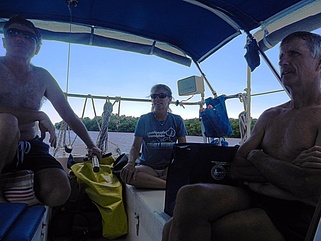 Returning from a snorkeling trip with Miami and Shelly
Returning from a snorkeling trip with Miami and Shelly Enough of the work stuff. . .
We managed to squeeze in a few things between projects. Miami and Shelly from Yume joined us for a snorkeling trip to Sombrero. And Captain Jack was our guest at the SSCA lunch at Hurricane. We got to meet the folks on Vixen, fellow Beneteau owners, who had been corresponding with us over the past couple of years. But there were a couple of stand-out events that we want to highlight.
We managed to squeeze in a few things between projects. Miami and Shelly from Yume joined us for a snorkeling trip to Sombrero. And Captain Jack was our guest at the SSCA lunch at Hurricane. We got to meet the folks on Vixen, fellow Beneteau owners, who had been corresponding with us over the past couple of years. But there were a couple of stand-out events that we want to highlight.
 Schooners crossing at sunset in Key West
Schooners crossing at sunset in Key West Sunset Sail in Key West
We made our annual trip to Key West and took a friend, Tarun, who had some business to attend to there. After the work was done, we wondered Duval St as usual, checked out the Eco-Discovery Center and had dinner on half-price appetizers at Alfonzo's Oyster Bar. However, by far the highlight of the trip was the opportunity to sail on the Spirit of Independence, a schooner captained by Tarun's friend, Captain Rick. It was a beautiful ship, a lovely evening and we felt like we had the run of the ship. Dave even took the helm for a bit. If you're ever in Key West, look for them on the wharf. You won't be disappointed.
We made our annual trip to Key West and took a friend, Tarun, who had some business to attend to there. After the work was done, we wondered Duval St as usual, checked out the Eco-Discovery Center and had dinner on half-price appetizers at Alfonzo's Oyster Bar. However, by far the highlight of the trip was the opportunity to sail on the Spirit of Independence, a schooner captained by Tarun's friend, Captain Rick. It was a beautiful ship, a lovely evening and we felt like we had the run of the ship. Dave even took the helm for a bit. If you're ever in Key West, look for them on the wharf. You won't be disappointed.
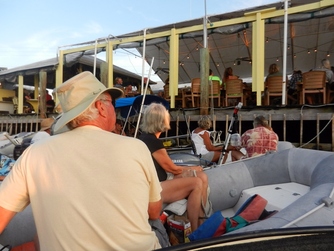 Dinghy raft-up at Docksides
Dinghy raft-up at Docksides Dinghy Concert at Docksides
For the first time, we participated in a Dinghy raft-up at Docksides, a bar that sits on the southeast edge of Boot Key Harbor. The occasion was a benefit for a local veteran. It was initiated by Gary Hannan, a songwriter from Nashville, who was on a tour to raise money for local vets. He was joined by 3 other local songwriters for a performance in the round. The unusual part was that Docksides allowed us to raft our dinghies outside to expand the audience. So we sat in comfort on the water and listened to some amazing performances. In the end, almost $2000 was raised for the benefit.
For the first time, we participated in a Dinghy raft-up at Docksides, a bar that sits on the southeast edge of Boot Key Harbor. The occasion was a benefit for a local veteran. It was initiated by Gary Hannan, a songwriter from Nashville, who was on a tour to raise money for local vets. He was joined by 3 other local songwriters for a performance in the round. The unusual part was that Docksides allowed us to raft our dinghies outside to expand the audience. So we sat in comfort on the water and listened to some amazing performances. In the end, almost $2000 was raised for the benefit.
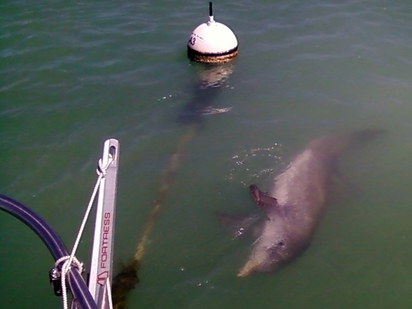 Dolphin playing around the mooring
Dolphin playing around the mooring Parting Shots
While Cathy was up on deck waxing one morning, a dolphin was circling the boat, which caught her attention. It turned out it was chasing a fish that was using our mooring ball and pennant as interference. I'm sure it didn't go well for the fish, but it was amusing to watch the chase.
While Cathy was up on deck waxing one morning, a dolphin was circling the boat, which caught her attention. It turned out it was chasing a fish that was using our mooring ball and pennant as interference. I'm sure it didn't go well for the fish, but it was amusing to watch the chase.
